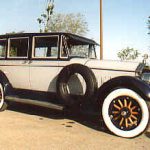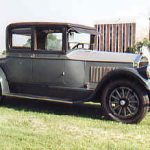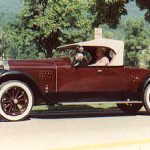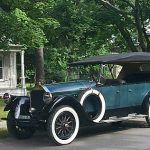- Home
- About Us
- Join/Renew
- Member Benefits
- Member Pages
- Log In
- Help
- Museum Store
In 1920, Colonel George Mixter, president of the Pierce-Arrow Motor Car Company, wanted to trim the line to a more manageable number of models than the sixty or so combinations of body and chassis available during the teens.

Only one chassis with ten factory body styles would be available. Some of the features of earlier years were maintained, but somewhat modified: the dual-valve engine was redesigned with mono-block construction and the cast aluminum body panels were replaced by panels made of 14 gauge aluminum, although window moldings, firewalls, and other parts were still cast. The bodies were designed by Leon Rubay and James Way and the steering wheel was finally moved to the left side. The traditional Pierce-Arrow ideals of quality continued. Each engine was run in, disassembled and inspected, and reassembled for more testing. Before being released, each car was driven by an inspector. The quality of the bodywork underwent similar quality control measures.

The new Pierce-Arrow appeared in late 1920 as the Series 32. Mechanical refinements were made in late 1921 and the car became the Series 33. With production continuing through early 1926, the Series 33 was Pierce-Arrow’s flagship model of the early 1920’s. About 6000 of the Series 33 cars were produced in the five year period. Prices for the Series 33 were expensive…ranging from $6500 to $8500, although price reductions brought the price down somewhat to $5250 to $8000. Minor changes in the sheet metal, balloon tires, and a few mechanical changes transformed the Series 33 into the Series 36, which was produced in 1927 and 1928

The heart of the Series 33 was the Dual-Valve Six engine. The engine was of the T-head arrangement with four valves per cylinder inclined five degrees toward the cylinder bore. The valves were operated by dual gear-driven camshafts in the crankcase. This arrangement of valves, along with the four-inch bore and five and one-half inch stroke made for a large 414 cubic inch combustion chamber. To ignite the mixture, a Delco dual-ignition system was used. This system used two spark plugs per cylinder, two coils, and two distributors. A refinement in 1924 was the replacement of dual distributors with a single, 14-tower unit, although dual coils, points, condensers, and plugs were maintained. Switches on the instrument panel allowed the car be be run on either the right or left set of spark plugs, or for maximum power, both sets simultaneously. The engine operated between 200 and 3000 rpm and developed 100 horsepower. This gave a top speed of 75 miles per hour and about 12 miles per gallon. Fuel was supplied from the tank at the rear of the car by a pressure system. The “Gasoline” gauge on the instrument panel measured air pressure, not gallons, which were measured by a separate, magnetically operated gauge located on the fuel tank. Other interesting features were the vacuum controlled oil pressure regulator that supplied more oil to the bearings when the engine was under a load, and the Kellogg air pump driven off the transmission to supply compressed air to inflate tires or the air springs. Continuing refinements brought four-wheel brakes and eventually vacuum assisted brakes to the Series 33.In late 1924, the Pierce-Arrow Motor Car Company introduced the Series 80, a less expensive alternative to the Series 33. While maintaining the quality construction and workmanship of the more expensive Series 33 cars, the Series 80’s were smaller and simpler in design. Rather than the Dual-Valve Six, the Series 80’s were powered by a 288.6 cubic inch L-head six. A Stewart vacuum tank was used to supply fuel instead of the pressure system. Only one set of valves and a single ignition system was used, although the Series 80 did use a reed-valve carburetor similar to the Series 33 cars. Prices ranged from $2895 to $4045 for the Series 80 cars. The Series 80 cars were quite popular, far outselling the Series 33 cars.

The Series 81 was introduced in 1928 as a refinement of the Series 80. The Series 81 maintained the basic 130 inch wheelbase chassis of the Series 80 with minor changes to the engine. James Way designed all new sheet metal for the Series 81 which continues to be controversial. Although Pierce-Arrow president Myron Forbes was enthusiastic about the new cars, the dealers and public were a little more reserved. The traditional Pierce-Arrow radiator design had been changed as had the curve of the fender headlamps, which now sported an “eyebrow”. The famous archer mascot made its debut on the Series 81 as did a badge on the radiator shell showing the Pierce family crest. The badge was removed for 1929, however, when Mrs. Percy Pierce informed the company that it was the coat-of-arms for the wrong Pierce family.
The 1920’s ended for Pierce-Arrow with another overhaul of the product line and renewed optimism based on financial soundness. While rumors about mergers with companies such as General Motors, Lafayette and Rolls-Royce circulated in the 20’s, none came true until controlling interest of the Pierce-Arrow Motor Car Company was purchased by the Studebaker Corporation in 1928. While the two companies maintained independent engineering and manufacturing operations, Pierce-Arrow’s future was influenced by its major stockholder, Studebaker.
